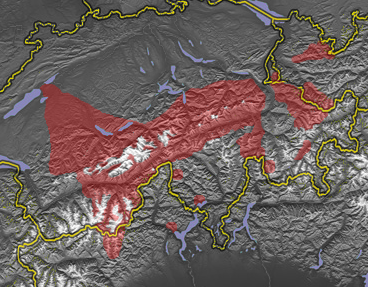  WalserLanguage WalserLanguage
|

|
Sigma KEE - WalserLanguage

|
|
WalserLanguage
|
|
The WalserLanguage is an AllemannicLanguage of Switzerland. SIL code: WAE. ISO 639-2: gem. Population: 10,000 to 20,000 speakers in Switzerland out of 21,900 population (1980 C. Buchli). Population total all countries: 20,000 to 40,000. Region: Bosco-Gurin, Canton Ticino, Wallis, Simplon, Graubunden, Obersaxen, Valsertal (Vals, St. Martin), Safiental (Valendas, Versam, Tenna, Safien), Rheinwald (Medels, Nufenen, Splngen, Sufers, Hinterrhein, Avers), Schanfigg (Arosa, Langwiesn), Albula (Mutten, Schmitte Wiesen), Landquart (Davos, Klosters, Furna, Says, St. Antonien, Valzeina). 26 communities in Switzerland, and 7 former ones. Also spoken in Austria, Italy, Liechtenstein. Alternate names: WALSCHER. Comments: Ancestors came from the Wallis Canton between the 12th and 13th centuries. Close but different from Schwytzertusch spoken in Wallis Canton in Switzerland. Different from Cimbrian, Mocheno, or Bavarian. Also spoken in: Austria. (Language name: WALSER.) Population: 5,000 to 10,000 in Austria (1995 C. Buchli). Alternate names: WALSCHER. Comments: Ancestors came from the Wallis Canton between the 12th and 13th centuries. Close but different from Schwytzertusch. Different from Cimbrian, Mocheno, or Bavarian. Also spoken in: Italy. (Language name: WALSER.) Population: 3,400 in Italy (1978 Fazzini). Alternate names: WALSCHER. Comments: Ancestors came from the Wallis Canton between the 12th and 13th centuries. Close but different from Schwytzertusch. Different from Cimbrian, Mocheno, or Bavarian. All ages. Used for children's services in church. In Valle d'Aosta it has been influenced by Franco-Provencal and Piemontese, elsewhere in Italy by Italian. Investigation needed: bilingual proficiency in Italian. Also spoken in: Liechtenstein. (Language name: WALSER.) Population: 1,300 in Liechtenstein (1995 C. Buchli). Alternate names: WALSCHER. Comments: Ancestors came from the Wallis Canton in Switzerland. Close but different from Schwytzertusch. Different from Cimbrian, Mocheno, or Bavarian.(extract from http://www.ethnologue.com/)
|
|
Relationships
|
|
|
|
| Instances | AllemannicLanguage | Of the eight UpperGermanLanguages, one is classified as an AllemannicLanguage.(extract from http://www.ethnologue.com/) |
| | ContentBearingPhysical | Un Object o Process que expresa contenido. Esto cubre los Objects que contienen una Proposition, como un libro, así como un ManualSignLanguage, por lo que puede contener una Proposition. |
| | Entity | La clase universal de individuos. Es el nodo principal de la ontología. |
| | GermanGroupLanguage | |
| | GermanicLanguage | A GermanicLanguage is any of 58 closely related IndoEuropeanLanguages spoken in the UnitedKingdom and northern and central Europe.(extract from http://www.ethnologue.com/) |
| | HumanLanguage | La subclass de Languages usados o sea «lenguajes naturales» por Humans. |
| | IndoEuropeanLanguage | There are 433 languages categorized as an IndoEuropeanLanguage, forming a major family of the world's languages and including many of the most familiar languages of Europe and South Asia.(extract from http://www.ethnologue.com/) |
| | Language | Un sistema de signos para expresar pensamientos. El sistema puede ser natural o artificial, por ejemplo, algo que emerge poco a poco como un artefacto cultural o algo se crea intencionalmente por una persona o grupo de personas. |
| | LanguageFamily | A LanguageFamily is group of SpokenHumanLanguages related through descent from a common ancestral language. (reference from https://en.wikipedia.org/wiki/Language_family) |
| | LinguisticExpression | Esta es la subclase de ContentBearingPhysical que es relacionada con idiomas. Note que esta Class abarca ambos Language y los elementos de Languages, por ejemplo Words «palabras». |
| | NaturalLanguage | La subclass de HumanLanguages (lenguajes naturales) que fueron diseñados y que evolucionaron de generación a generación. Esta clase incluye todos los lenguajes nacionales como el inglés, el español y el japonés, etc. Note que esta clase incluye los dialectos de lenguajes naturales. |
| | Physical | Una entidad que tiene ubicación en espacio-tiempo. Note que las ubicaciones se entienden tener sitio en espacio-tiempo. |
| | UpperGermanLanguage | Of the 17 GermanGroupLanguages, eight are classified as an UpperGermanLanguage.(extract from http://www.ethnologue.com/) |
| | WestGermanicLanguage | |
|
Belongs to Class
|
Entity |
| | |
 |
Show full definition (without tree view)
Show full definition (with tree view)
|